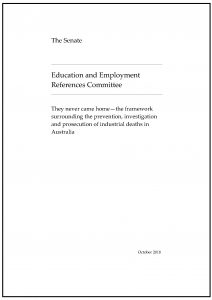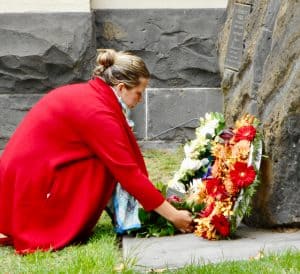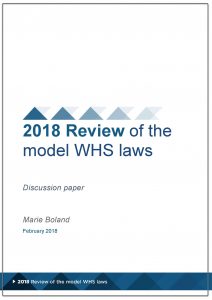Already a member? Log in here
Category: red tape
One of the most useful books about OHS law
 It is difficult to make a book about occupational health and safety (OHS) law interesting. Some try with creative design but the most successful is when laws are interpreted into real world circumstances. Thankfully Breen Creighton and Peter Rozen have written the latter in the 4th edition of Health and Safety Law in Victoria. Independent Australian publishers, Federation Press, recognise the significance of this edition:
It is difficult to make a book about occupational health and safety (OHS) law interesting. Some try with creative design but the most successful is when laws are interpreted into real world circumstances. Thankfully Breen Creighton and Peter Rozen have written the latter in the 4th edition of Health and Safety Law in Victoria. Independent Australian publishers, Federation Press, recognise the significance of this edition:
“This is an entirely re-written and greatly expanded edition of this standard text on occupational health and safety law in Victoria….[and]
…Critically, the new edition locates the 2004 Victorian Act firmly in the context of the harmonised work health and safety regime…”
This discussion of context lifts this book from an analysis of one State’s OHS laws to an analysis of harmonisation, which may be offer a useful counterpoint to
Much is being asked of Safe Work Australia by Senate inquiry on industrial deaths
 One of the noticeable things about the Australian Senate’s report into industrial deaths is the workload it expects Safe Work Australia (SWA) to do in the implementation of the 34 official recommendations. Whether Safe Work Australia has the capacity and skills to undertake these tasks is not addressed.
One of the noticeable things about the Australian Senate’s report into industrial deaths is the workload it expects Safe Work Australia (SWA) to do in the implementation of the 34 official recommendations. Whether Safe Work Australia has the capacity and skills to undertake these tasks is not addressed.
The Senate report expects Safe Work Australia to develop various data-sets and public lists and to work with State and Territory occupational health and safety (OHS) regulators. But the lessons from OHS harmonisation and Safe Work Australia’s Model Laws reinforced that workplace health and safety is controlled by the States and Territories and that, although an Inter-Governmental Agreement was signed, party and local politics knobbled the harmonisation program so that several years on, Australian OHS laws are only slightly more harmonised than they were before the program began.
In the early 1990s, a program for National Uniformity of OHS laws was cancelled for political reasons. Prior to harmonisation there were strong calls for a national OHS regulator but this could not be undertaken without Constitutional reform. That lack of a single National OHS regulator is all over this Senate inquiry report.
‘Safety Clutter’ and what to do about it
 Many companies have bloated workplace procedures. Many of these seem to involve workplace health and safety. Some people blame this on a bureaucracy designed in the olden times by someone, that somehow still exists and is maintained by someone or some process that no one sees or knows. Some prominent Australian researchers have looked into this issue and have written about “safety clutter”* which they say is:
Many companies have bloated workplace procedures. Many of these seem to involve workplace health and safety. Some people blame this on a bureaucracy designed in the olden times by someone, that somehow still exists and is maintained by someone or some process that no one sees or knows. Some prominent Australian researchers have looked into this issue and have written about “safety clutter”* which they say is:
“…the accumulation of safety procedures, documents, roles, and activities that are performed in the name of safety, but do not contribute to the safety of operational work.”.”
Industrial Manslaughter laws likely for Victoria
 With little surprise, at the Australian Labor Party (ALP) Conference in Victoria on 26 May 2018, Premier Daniel Andrews has included the introduction of Industrial Manslaughter laws as a formal part of the campaign for re-election in November 2018.
With little surprise, at the Australian Labor Party (ALP) Conference in Victoria on 26 May 2018, Premier Daniel Andrews has included the introduction of Industrial Manslaughter laws as a formal part of the campaign for re-election in November 2018.
According to his media release, if re-elected,
“.., employers will face fines of almost $16 million and individuals responsible for negligently causing death will be held to account and face up to 20 years in jail.
A re-elected Andrews Labor Government will make sure all Victorians are safe in our workplaces, with the offence to also apply when an employer’s negligent conduct causes the death of an innocent member of the public..”
There are a lot of steps between an incident and Industrial Manslaughter charges.
Melbourne’s Worker Memorial ceremony
 The Melbourne ceremony for International Workers Memorial Day was held on 27 April 2018 and had a good turnout. The standout “speaker” was Lana Cormie (pictured right), whose husband, Charlie Howkins in a trench collapse in March 2018, a work colleague died later in hospital from injuries from the incident. Victorian Trades Hall’s Luke Hilakari was fired up in his talk about the importance of occupational health and safety (OHS) and the need for Industrial Manslaughter laws.
The Melbourne ceremony for International Workers Memorial Day was held on 27 April 2018 and had a good turnout. The standout “speaker” was Lana Cormie (pictured right), whose husband, Charlie Howkins in a trench collapse in March 2018, a work colleague died later in hospital from injuries from the incident. Victorian Trades Hall’s Luke Hilakari was fired up in his talk about the importance of occupational health and safety (OHS) and the need for Industrial Manslaughter laws.
Cormie’s speech was read out by
The review of Australia’s OHS laws starts
 In 19 February 2018, Safe Work Australia (SWA) “launched” the independent review of Australia’s Work Health and Safety laws under former Executive Director of SafeWorkSA, Marie Boland. SWA has released a 49-page discussion paper, a summary and a list of questions. Below is an initial response to some of those questions.
In 19 February 2018, Safe Work Australia (SWA) “launched” the independent review of Australia’s Work Health and Safety laws under former Executive Director of SafeWorkSA, Marie Boland. SWA has released a 49-page discussion paper, a summary and a list of questions. Below is an initial response to some of those questions.
What are your views on the effectiveness of the three-tiered approach – model WHS Act supported by model WHS Regulations and model WHS Codes – to achieve the object of the model WHS laws?
The structure works well, when business owners know of the relevant documents.
